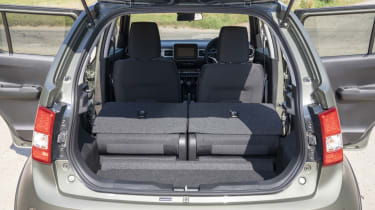Suzuki Ignis review - Practicality, comfort and boot space
The Ignis is far more practical than you’d expect, with the sliding rear seats a real boon

Take one look at the tiny dimensions of the Ignis, and you’d be forgiven for assuming it’s not very practical. But you’d be wrong - Suzuki has done a great job of squeezing the maximum amount of space available from the slim bodywork.
The key thing that helps to make the most of the Ignis’ space is the sliding rear bench seat, which is standard on SZ-T models and above. It can be moved forward and aft up to 165mm to allow buyers to choose between rear legroom and boot capacity. The seat backs recline, too, while storage is decent, taking the form of big door bins, two central cupholders and a split glovebox.
Visibility from the driver’s seat of the Ignis is very good, mainly thanks to the high-up driving position. It’s a characteristic taken from larger crossovers that will please city dwellers, and makes the Ignis very easy to thread between traffic.
Size
The Ignis is 3.7m long and 1.6m wide, making it a fair bit longer and slightly wider than both the Celerio and rival city cars like the Skoda Citigo. It’s surprising given the Ignis is meant to be less practical than the Celerio, but it translates into a good amount of space for occupants.
Legroom, headroom and passenger space
We’ve yet to try an Ignis without the sliding rear seat bench but with it fitted, four average-sized adults will find a surprising amount of legroom and even decent headroom – impressive given the car’s sloping roofline. The two-position reclining backrest also makes things more comfortable.
Obviously, if you slide the seats forward to prioritise boot space, legroom is reduced, while the Ignis’ slim width means there’s little hope of carrying three passengers in the back, especially because there are only two seatbelts in the back. Still, the same can be said for other city cars.
Boot
The Ignis’s boot space for models without the sliding rear seat is a sizeable 267 litres, although it’s worth remembering that the capacity changes to 204 litres if you opt for the four-wheel drive model. You can fold the back seats to increase that space to 1,100 litres, which is also a very good size for the class. In comparison, a Kia Picanto has a 255-litre load capacity, and the Hyundai i10 252 litres.









